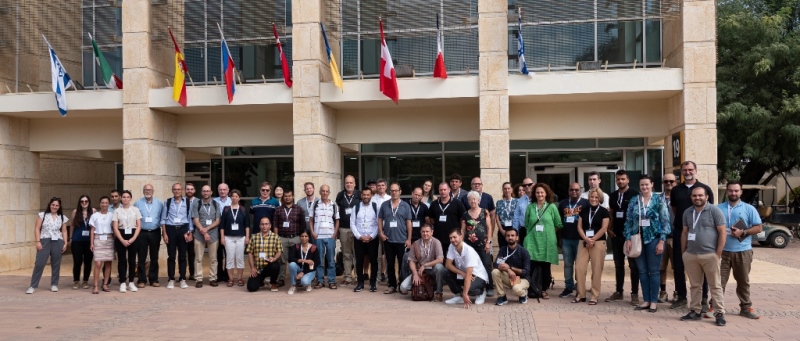The 23rd Sede Boqer Symposium on Solar Electricity Production was held between September 5 – 7, 2022 – at the Blaustein Institutes for Desert Research campus, after a hiatus of exactly three years since the last one. This symposium was a great success for a number of reasons, including the active participation of 120 participants from academic institutions from nine different countries. Notably, scientists from all major Israeli universities and many colleges came and we could feel the camaraderie as colleagues had the chance to meet each other again in this forum and location. One comment by someone who was unable to come at the last minute due to Covid, “There are many people who I haven't seen for a long time and I'll really miss attending".
Following the tradition of these symposia, it combined within a single event (without parallel sessions) presentations on all types of conversion of solar energy to electricity, namely photovoltaics, concentrated solar power, photo-electrochemistry and hybrid technologies. The lectures and posters addressed all levels of current experimental and theoretical research in these areas: fundamental physico-chemical processes, materials (including materials science on the nanoscale), devices and systems including novel nontraditional applications of solar electricity (agro-photovoltaics, etc).
Three
key-note lectures followed by intensive discussions were presented by outstanding world-renowned scientists:
-
“Accelerating Lifetime Engineering of Emerging-PV Technologies" by Professor Christoph Brabec, University of Erlangen, Germany;
-
“Semiconductor Nanocrystals for Photocatalytic Applications" by Professor Uri Banin, Hebrew University of Jerusalem, Israel;
-
“MXenes – Synthesis, Optoelectronic Properties and Solar Energy Applications" by Professor Yury Gogotsi, Drexel University, Pennsylvania, USA.
I would like to stress that all three key-note speakers are pre-eminent scholars in both basic and applied research.
Twenty-nine
invited talks were spread over three days and eight sessions including:
-
Broader Perspectives and New Ideas in Photovoltaics;
-
Perovskite photovoltaics I (basic science);
-
Perovskite photovoltaics II (stability and sustainability);
-
Theoretical studies;
-
Electrochemistry and Photoelectrochemistry;
-
Organic Photovoltaics;
-
Agro-Photovoltaics;
-
Solar Thermal Technologies.
All sessions were chaired by world-class experts in their respective research fields.
The session on
Agro-Photovoltaics (which was organized for the first time in our Symposia) was chaired by Professor Naftali Lazarovich, the director of the BGU French Associates Institute for Agriculture and Biotechnology of Drylands. He added an agricultural perspective to the discussion.
In addition to the academic presentations and discussions, a
special panel session was devoted to the industrial production of solar electricity in Israel, and particularly to a review of the progress and the current status of the Ashalim Solar Station project from the government and the companies' perspective. The question that we were hoping to learn is if and how the project has helped Israel towards its own goals for renewable energies. The session was comprised of presentations of high level experts from the government and industrial producers of solar electricity, namely: Yuval Zohar (Head of Policy, Planning & Emergency, Electricity Authority), Achiam Tigger (Negev Energy Ashalim), Pierre Kohn (EDF Renewables - Israel), and Nimrod Levy (ICL).
Thirty-nine posters were presented and discussed during two poster sessions. A committee comprised of Prof. Yana Vaynzof (Technical University of Dresden), Dr. Avi Niv (BGU) and Dr. Doron Azulay (Hebrew University of Jerusalem) discussed all posters presented by students and awarded three prizes (in order of excellence) to:
-
René Daniel Méndez López of Bar-Ilan University for his poster “Pb Sequestration to Prevent Possible Pollution of the Environment from Halide Perovskite-based Devices";
-
Ekatarina Shabratova of Helmholtz-Zentrum Berlin for her poster “Investigating Fine Electronic Structure in Carbon Nitride Materials by Electron Paramagnetic Resonance Spectroscopy";
-
Sudhakar Vediappan of Ben-Gurion University of the Negev for his poster “Novel Interlayer Between the Photoactive and Hole Conductive Layer in Perovskite Solar Cells".
This year, we were again able to subsidize student participation, and we saw a larger-than-usual contingent of young people attracted to the field.
The Symposium would not have been complete without an extraordinary social event “Astronomy – The Desert Skies in September". It gave us an opportunity to observe the wondrous night sky under the dark-sky conditions of the Makhtesh Ramon Crater through telescopes.
Last but not least, some well-deserved acknowledgements. We highly appreciate the generous help of our sponsors: The Ministry of Energy and Ben Gurion University itself, including the offices of the President and the Rector, the Jacob Blaustein Center for Scientific Cooperation, the Swiss Institute for Dryland Environmental and Energy Research and the BGU Center for Energy and Sustainability.
We acknowledge with gratitude the tireless efforts of the Conference Administrator Shoshana Dann, ably assisted by Debi Zamir, without whom the symposium would not have been possible. Very much appreciated is also the help in all logistics by the staff of the Blaustein Institutes for Desert Research as well as the team of our students.
Professor Eugene Katz
September 2022

Thank you all for participating!




